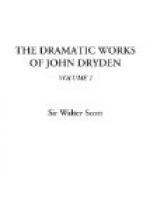I have thus detailed the life, and offered some remarks on the literary character, of JOHN DRYDEN: who, educated in a pedantic taste, and a fanatical religion, was destined, if not to give laws to the stage of England, at least to defend its liberties; to improve burlesque into satire; to free translation from the fetters of verbal metaphrase, and exclude it from the licence of paraphrase; to teach posterity the powerful and varied poetical harmony of which their language was capable; to give an example of the lyric ode of unapproached excellence; and to leave to English literature a name, second only to those of Milton and of Shakespeare.
FOOTNOTES [1] Life and Works of Arthur Maynwaring, 1715, p. 17.
[2] So says Charles Blount, in the dedication to the Religio Laici. He is contradicted by Tom Brown.
[3] In a poem published on Dryden’s death, by Brome, written, as Mr. Malone conjectures, by Captain Gibbon, son of the physician.
[4] In “The Postboy,” for Tuesday, May 7, 1700, Playford inserted the following advertisement:
“The death of the famous John Dryden, Esq., Poet-Laureate to their two late Majesties, King Charles, and King James the Second, being a subject capable of employing the best pens; and several persons of quality, and others, having put a stop to his interment, which is designed to be in Chaucer’s grave, in Westminster Abbey; this is to desire the gentlemen of the two famous Universities, and others, who have a respect for the memory of the deceased, and are inclinable to such performances, to send what copies they please, as Epigrams, etc., to Henry Playford, at his shop at the Temple ’Change, in Fleet Street, and they shall be inserted in a Collection, which is designed after the same nature, and in the same method (in what language they shall please), as is usual in the composures which are printed on solemn occasions, at the two Universities aforesaid.”
This advertisement (with some alterations) was continued for a month in the same paper.
[5]
“Thy reliques, Rowe, to this fair
urn we trust,
And sacred place by Dryden’s awful
dust:
Beneath a rude and nameless stone he lies,
To which thy tomb shall guide inquiring
eyes:
Peace to thy gentle shade, and endless
rest!
Blest in thy genius, in thy love too,
blest!
One greatful woman to thy fame supplies,
What a whole thankless land to his denies.”
[6] The epitaph at first intended by Pope for this monument was,
“This Sheffield raised; the sacred
dust below
Was Dryden once:—the rest,
who does not know?”
Atterbury had thus written to him on this subject, in 1720: “What I said to you in mine, about the monument, was intended only to quicken, not to alarm you. It is not worth your while to know what I meant by it; but when I see you, you shall. I hope you may be at the Deanery towards the end of October, by which time I think of settling there for the winter. What do you think of some such short inscription as this in Latin, which may, in a few words, say all that is to be said of Dryden, and yet nothing more than he deserves?




